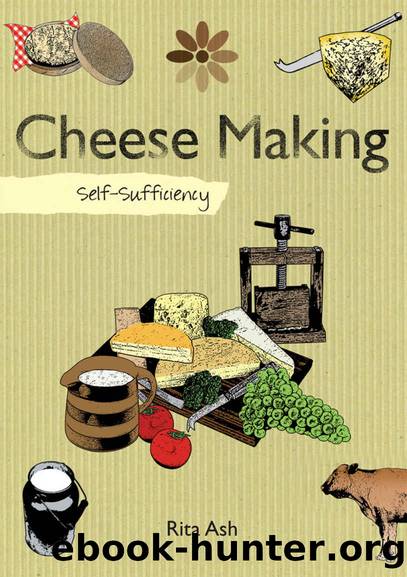Self-Sufficiency Cheese Making: Essential Guide for Beginners by Rita Ash

Author:Rita Ash [Ash, Rita]
Language: eng
Format: azw3
Publisher: IMM Lifestyle Books
Published: 2015-10-29T16:00:00+00:00
Serving suggestion
A good Derby is a soft, moist cheese which is better on the cheeseboard than for cooking. It does, however, make acceptable flans and sauces when blended with a strong, mature cheese such as Cheddar.
5. Continue cutting, turning and removing the whey at 20 minute intervals for 2 hours until the blocks are firm but still very moist. Mill or break the curd into cherry sized pieces and place back in the vat, turning the pieces frequently to prevent them sticking together.
6. Add 1.5 grams of salt per litre (1¾ pints) of milk used and stir thoroughly. Pack carefully into a mold or molds lined with damp cheesecloth, pressing down lightly with your knuckles as you do so. Fold over the cloth and add a rigid disc or follower. Apply just enough pressure to cause the whey to run, being very careful not to over-press, and leave in a warm room for 6–8 hours.
7. Turn the cheese upside down into a clean damp cloth. Return to the mold and apply medium pressure. The following day turn twice, once onto a clean dry cloth and once without a cloth, applying medium pressure on both occasions. Remove from the press and leave in a cool, well-ventilated room for 24 hours to surface dry.
8. Remove from the press, coat the cheese with butter or oil and put into store. Turn daily during the first week and twice weekly thereafter. Derby is a moist cheese and is susceptible to damage. Clean regularly during storage and check regularly for signs of cracking and mould growth and fill any cracks with butter or oil immediately. Dry, powdery grey or green moulds can be rubbed off with a dry cloth or paper towel. Sticky, wet or highly coloured moulds must be washed off with cold water, the cheese dried and then re-greased.
9. Derby is a mild cheese and ready for eating after as little as four weeks. It is not usually improved by keeping for more than twelve weeks.
Download
This site does not store any files on its server. We only index and link to content provided by other sites. Please contact the content providers to delete copyright contents if any and email us, we'll remove relevant links or contents immediately.
101 Whiskies to Try Before You Die by Ian Buxton(44745)
World's Best Whiskies by Dominic Roskrow(44695)
Whiskies Galore by Ian Buxton(41821)
Craft Beer for the Homebrewer by Michael Agnew(18127)
Right Here, Right Now by Georgia Beers(4111)
Not a Diet Book by James Smith(3326)
Water by Ian Miller(3115)
The Coffee Dictionary by Maxwell Colonna-Dashwood(3052)
Kitchen confidential by Anthony Bourdain(2994)
Coffee for One by KJ Fallon(2549)
Smuggler's Cove: Exotic Cocktails, Rum, and the Cult of Tiki by Martin Cate & Rebecca Cate(2456)
Superfood Smoothie Bowls: Delicious, Satisfying, Protein-Packed Blends that Boost Energy and Burn Fat by Chace Daniella(2373)
Talking as Fast as I Can by Lauren Graham(2369)
Beer is proof God loves us by Charles W. Bamforth(2361)
Bourbon: A Savor the South Cookbook by Kathleen Purvis(2234)
A Short History of Drunkenness by Forsyth Mark(2221)
Eat With Intention by Cassandra Bodzak(2139)
Cocktails for the Holidays by Editors of Imbibe magazine(2070)
Colombia Travel Guide by Lonely Planet(2053)
